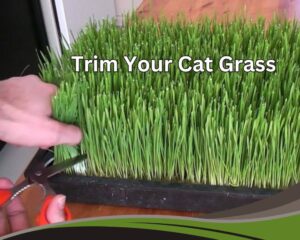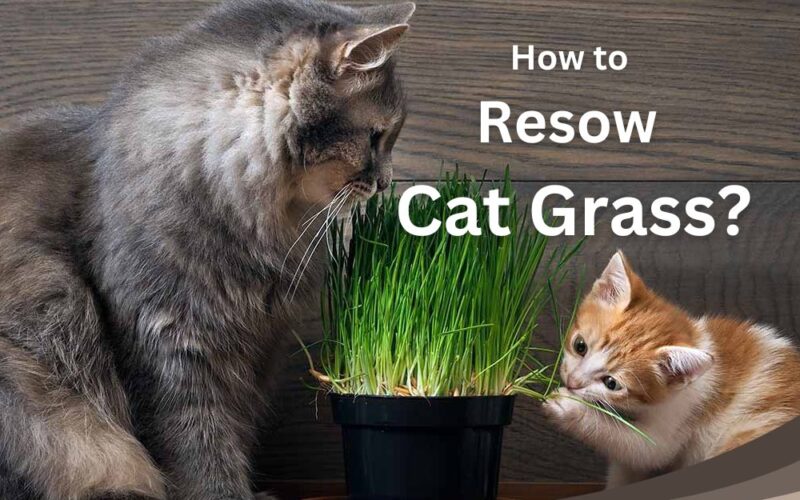If you spot the cat grass is starting to look worn out and are searching the ways to resow it, join this article to find out all the things you should know to resow cat grass.
Do you know why your cat eats grass? Cats love to chew the grasses while playing with it (they actually play with all things, I love them). Nibbling the grass has a lot of benefits for your feline friend such as improving the its digestive system.
So, most cat owners try to enhance the well-being of their cats by providing them with fresh safe indoor grasses that we call “Cat Grass”. But they have a limited lifespan and you have to resow cat grass. I discussed growing and taking care of cat grass indoors in my previous articles, here, I want to tell you about the ways of resowing it. keep reading.
➡ You can also hear the audio version of this article.
Why You Should Resow Cat Grass?

If you want to resow cat grass to provide fresh, tender grass for your cat, keep reading to tell you more reasons. Resowing cat grass is essential for several reasons:
Health Benefits: as you know, cat grass provides valuable nutrients, including vitamins and minerals, that can aid in digestion and help prevent the buildup of hairballs. But if you want to maximize these benefits, it’s crucial to have a continuous supply of young, vibrant grass.
Renewal: Cat grass can become overgrown, damaged, or unsightly over time due to your cat’s chewing and playing. Resowing allows you to replace the older, worn-out grass with new, healthier plants.
Hygiene: Indoor cat grass containers can accumulate dirt, debris, and even mold over time. It is usually more important when you use the pots without holes. So, you must start fresh with a new planting to help maintain a clean and safe environment for your cat.
Entertainment: Cat grass provides a source of stimulation and entertainment for your feline friend. They enjoy nibbling on the grass, which can be both mentally and physically stimulating. Resowing ensures a constant source of this entertainment.
And finally, the Aesthetics reasons: Cat grass can add a touch of greenery to your home, making it more visually appealing. Resowing keeps the grass looking lush and attractive.
Now, let to deal with how to resow your cat grass. In the following I provide you with the best tips, keep reading.
The Best Practices to Resow Cat Grass?
There are several ways to resow cat grass, here I want to tell you two common ways that can help you in providing fresh grass for your feline friend. Keep reading:
1: Trimming Your Cat Grass and Letting it to Regrowth

Let to start with the easiest way to resow cat grass. Instead of completely resowing, you can trim the existing cat grass to encourage regrowth. To do it:
- you can use scissors or shears to cut the grass blades down.
- Cut them about an inch above the soil.
- Fertilize your grass with a balanced, water-soluble fertilizer diluted to half the recommended strength. it will promote the growth of your cat grass but avoid over-fertilizing, as this can harm the plants.
Trimming allows the grass to grow back, providing a fresh source of cat grass without replanting. Do you know why you must trim your grass?
Why You Must Trim the Cat Grass?
Plants have a growth hormone called Auxin. It is produced in the tips of their shoots and branches and causes them to get longer and longer but prevents the growth of lateral branches lower down on the plant.
So, when you trim your cat grass, you remove the source of producing Auxin and your grass star to produce new lateral branches. Hence, to resow cat grass, trimming will have several benefits:
- Stimulating the natural growth patterns of your grass.
- Creates a fuller, more attractive appearance by promoting branching and bushier growth.
- preventing it from becoming too tall or leggy (Preventing Legginess)
- Maintaining Nutrient Density: The tender, young leaves at the tips of the grass blades are typically the most nutritious part. By trimming, you encourage the regrowth of these nutrient-rich leaves, ensuring your cat has a fresh and healthy source of greenery to nibble on.
- Prolonging the Growing Season: Trimming can extend the overall lifespan of the cat grass plant. When the grass becomes too tall and starts to flower, it often redirects energy away from leaf production. By trimming, you delay or prevent flowering, keeping the plant in a vegetative growth state for a longer period.
You can use the harvested grass to feed your rabbits if your grass type is also one of the best grasses for rabbits. However, your cat grass has a limited lifespan and you have to replant it. Do you know how long your cat grass lasts? Keep reading.
How Long Does Cat Grass Last?
several factors have an impact on the lifespan of cat grass including:
- Type of Grass: As you know cat grass includes various types of grass that are safe for your cat which I mentioned in my previous article about harvesting cat grass seeds. Different varieties of grass, such as wheatgrass or oatgrass, may have slightly different growth and lifespan characteristics. Wheatgrass, for example, tends to grow faster but may not last as long as oatgrass.
- Growing Conditions: Proper care, including adequate watering and exposure to sunlight or grow lights, can extend the life of your cat grass. If you neglect its care, it may not last as long.
- Cat’s Activity: If your cat is very playful and frequently chews on the grass, it will likely wear out more quickly. Some cats are gentler with their grass than others.
- Regrowth by trimming: Trimming encourages new growth and keeps the grass fresh.
However, cat grass will last for a few weeks to a couple of months and you have to resow it in other ways.
2- Resowing new cat grass

After your cat has nibbled on the existing cat grass and it starts to look worn out, you have to replant it. you can do it in several ways:
2-1: resow cat grass in the same pot
Resowing cat grass in the same pot is a convenient way to ensure a continuous supply for your cat. To do this successfully, I provide you with steps and factors in the following, please consider them.
- Prepare the Pot: Start by removing any remaining cat grass that has become too old or overgrown. You can gently pull out the old plants or cut them down to the soil level.
- Loosen the Soil: Use a small gardening tool or a fork to gently loosen the top inch of the potting soil. This helps create a suitable environment for the new seeds to take root.
- Sow Fresh Seeds: Sprinkle fresh cat grass seeds evenly over the loosened soil. You don’t need to bury the seeds; just press them lightly into the soil’s surface.
- Cover the Seeds: Sprinkle a thin layer of potting soil or vermiculite over the newly sown seeds. This helps to keep the seeds in place and maintains moisture.
- Water Gently: After sowing the seeds, water the pot gently using a spray bottle or a watering can with a fine rose attachment. Avoid drenching the soil, as cat grass seeds can easily wash away or become too deeply buried.
- Provide a Lot of Light: Place the pot in a location with plenty of indirect sunlight or direct sunlight for a few hours each day. Cat grass requires sunlight for healthy growth.
- Maintain Moisture: Keep the soil consistently moist but not waterlogged. Ensure that the pot has proper drainage to prevent root rot. Water as needed to keep the soil from drying out.
- Monitor Growth: Cat grass typically germinates within a week and starts growing quickly. As it grows, your cat can start enjoying it once it reaches a suitable height (usually around 4-6 inches).
- Regular Trimming: as mentioned in the first way you can encourage bushier growth and prevent the grass from becoming too leggy by trimming the cat grass occasionally.
- Fertilization: as I told you above, cat grass doesn’t typically require a lot of fertilizer, you can use a balanced, water-soluble fertilizer diluted to half the recommended strength to promote healthy growth. Fertilize sparingly, typically once a month.
If you want to know more details about how to grow cat grass indoors from seed, I discussed it in my previous article.
2-2: Use Indoor Cat Grass Kits
It is very easy, you can purchase indoor cat grass kits from your local center. It includes everything you need: seeds, soil, and a container. Follow the instructions provided in the kit for easy resowing.
2-3: Resow Cat Grass in Seed Trays
Seed trays or flats are shallow containers with multiple compartments. Fill these compartments with potting soil and sow cat grass seeds in each one. I strongly recommend this method to resow cat grass if you want to grow cat grass in smaller quantities or for multiple cats.
2-4: Resow Cat Grass by Outdoor Planting
If you are in a suitable season and have a garden or outdoor space, you can also resow cat grass outdoors. It will let you create a designated area for cat grass in your garden and sow the seeds directly into the soil. please select the area where your grass receives enough sunlight. You must water it regularly.
Conclusion
Now you know how to resow cat grass by trimming or replanting. I suggest you try all the ways and select the best one. do you know a new way to resow your grass? Do you usually grow it in which one: a pot or a seed tray? I prefer to plant my cat grass in several shallow trays, how about you?
Please tell us about your experiences and ideas below this page and I also can help you if you have any problem with this issue.

Elahe Rabiei
Hi, I’m Elaheh. My Academic major is plant protection, and houseplants are my expertise. As a houseplant lover, my house is full of indoor plants and it is my passion to take care of them. Hence, I’m here to share my knowledge and experience about growing healthy houseplants. I am also a plant protection advisor, so feel free to ask me any questions you may have.

